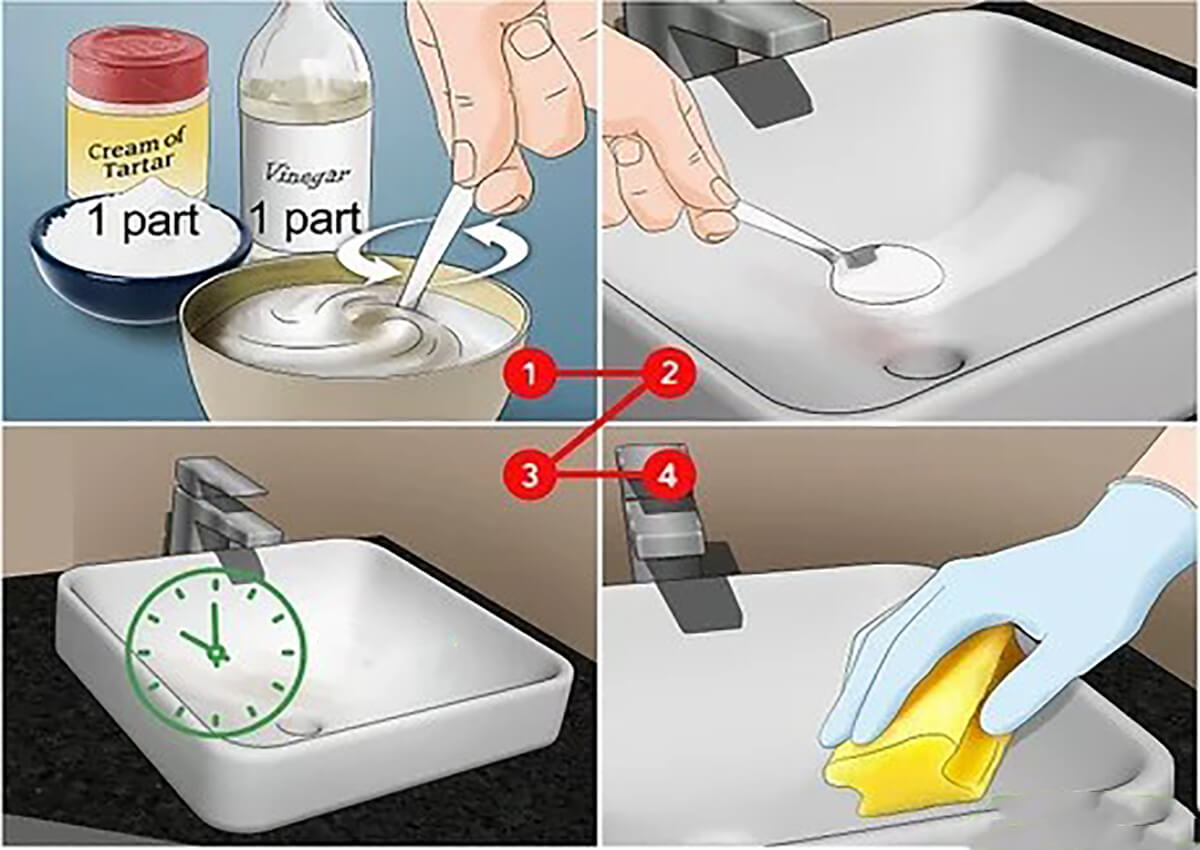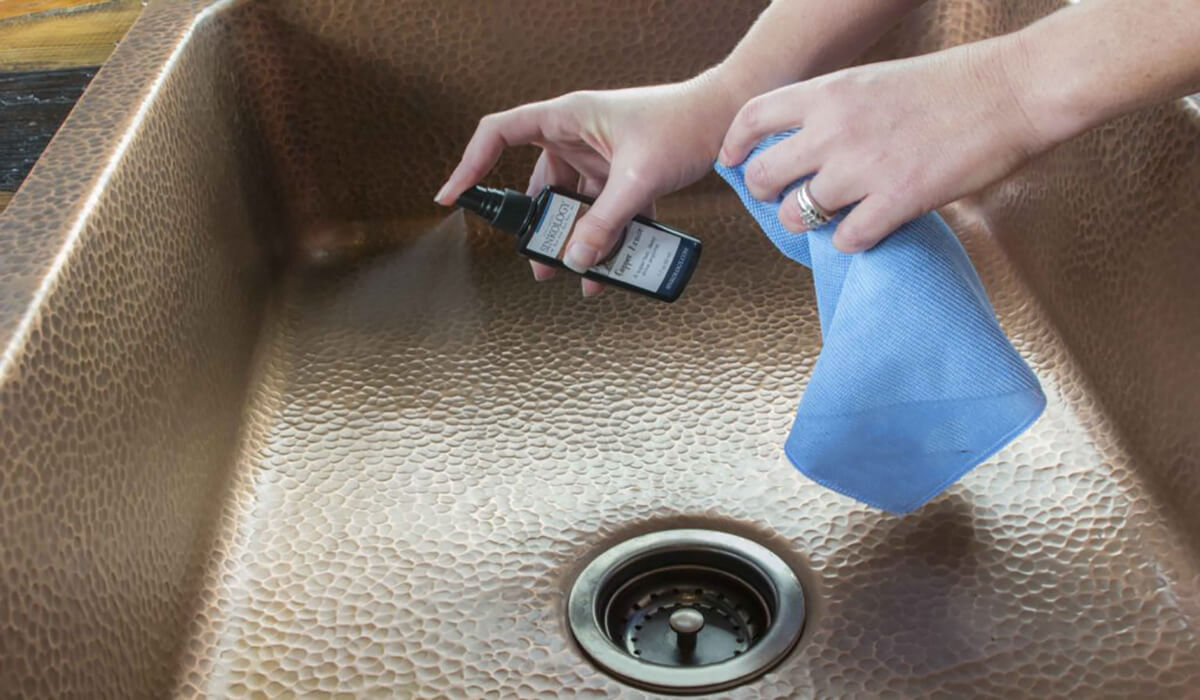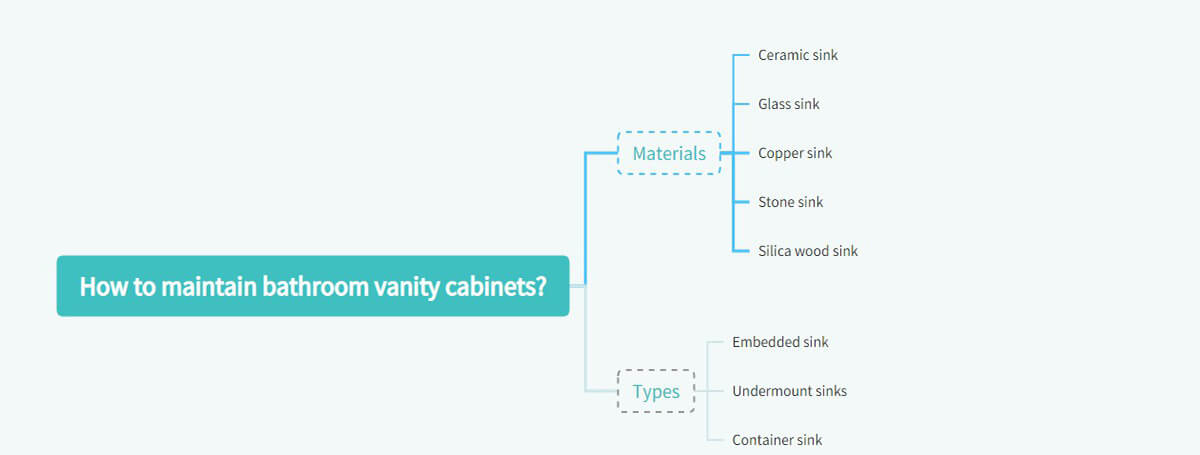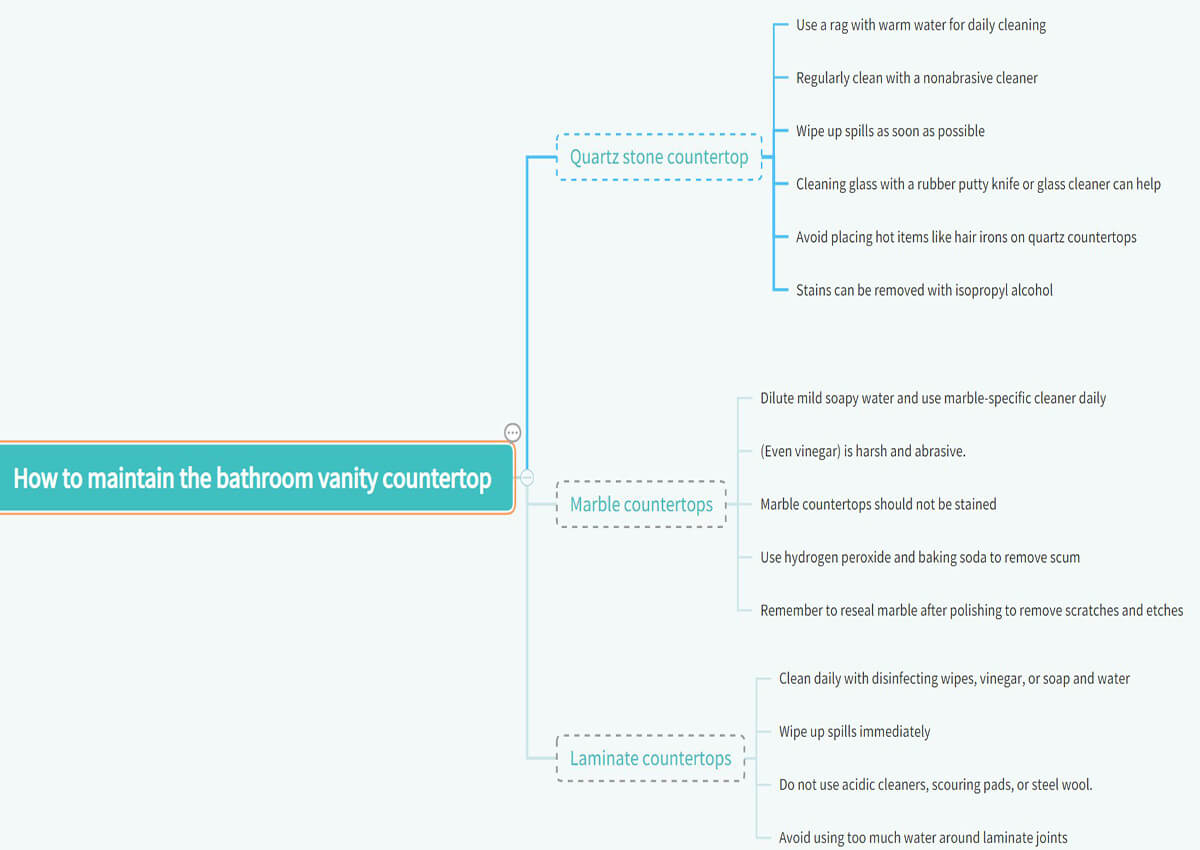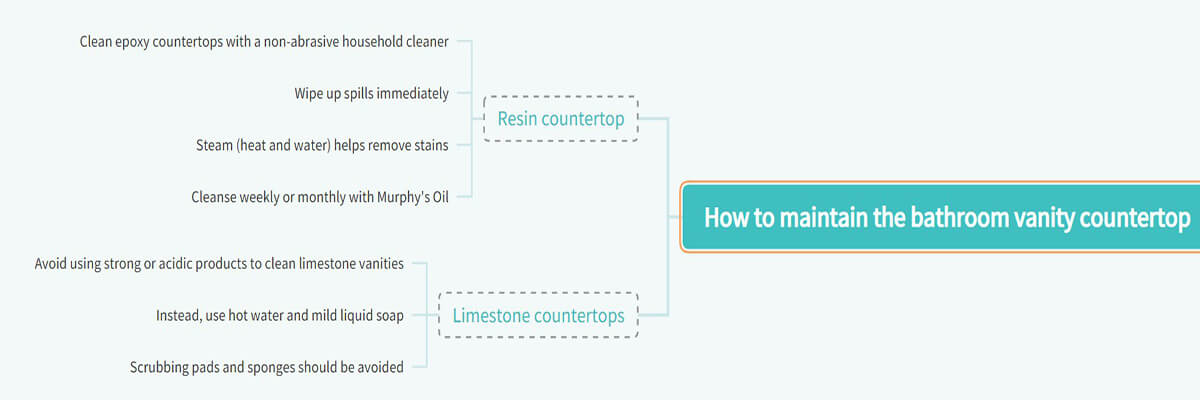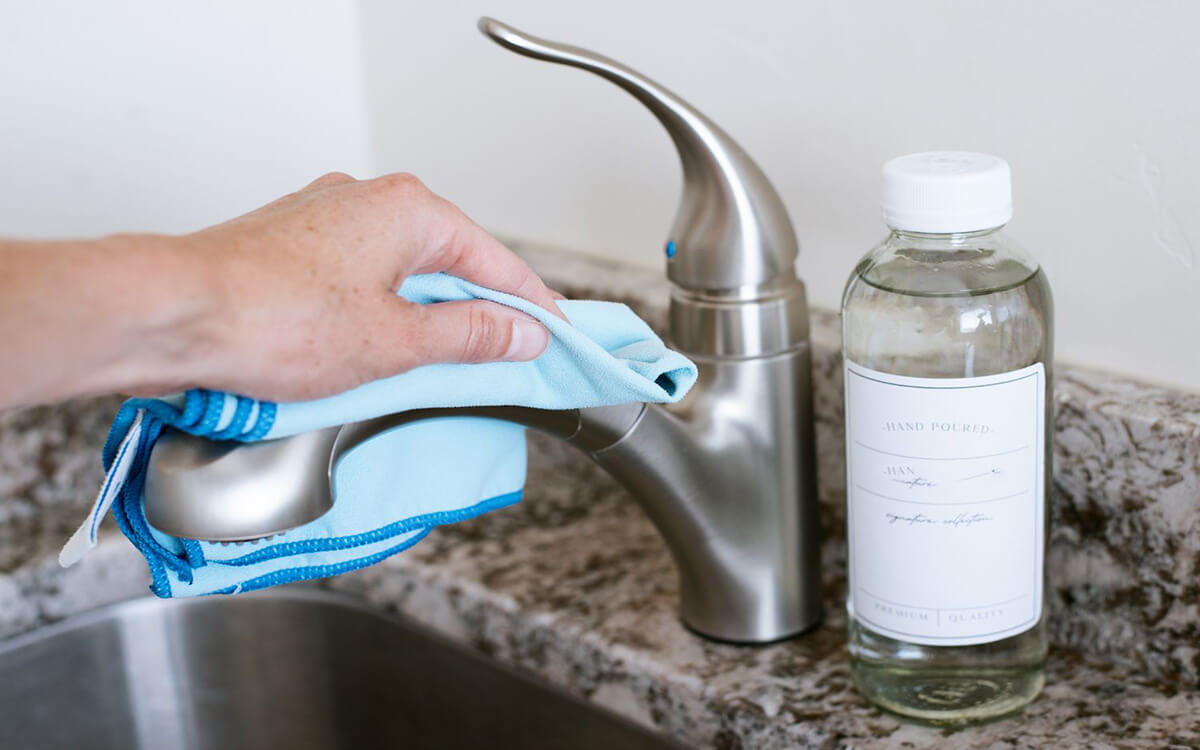While every well-made bathroom vanity by bathroom vanity manufacturers can withstand the harsh conditions of an average bathroom, over time they can start to look a bit worn and weathered unless they are properly cared for. Don’t worry. In today’s guide, we will cover how to maintain a bathroom vanity. Read on for more information.
1. How to maintain bathroom vanity cabinets?
Vanity cabinets are where bathroom supplies are stored and are often installed with backsplashes. Therefore, dust is less likely to accumulate inside the cabinet. Generally, you only need to wipe the surface of the cabinet regularly to keep it clean. Cabinets can be made of a variety of materials, and different materials require different maintenance methods. Depending on the material of your vanity cabinets, you will have a few different cleaning options.
1) Laminate bathroom vanity cabinets
Laminate vanities are an affordable alternative to wood vanities and are also easier to clean. They may look like wood cabinets, but they are actually laminate glued to particle board. You can help maintain the appearance of your laminate cabinets by dusting them regularly with a microfiber cloth. Laminate vanities can also be cleaned with mild soap and water, although natural or commercial cleaning products can be used.
Avoid using any abrasive cleaners and keep the material from getting too much water on it. After cleaning, dry the cabinet with a soft cloth. If you have a stain, mix baking soda with water to form a paste that can be removed by gently brushing over the stain with a soft-bristled brush. Then, wipe off the paste with a clean damp cloth.
2) Wood bathroom vanity cabinets
Wood can make beautiful cabinets, but it also requires careful maintenance. Do not use all-purpose cleaners on wood. Instead, for regular cleaning, all you need is a small amount of mild soap and warm water. Wipe with a cloth or sponge, then wipe off and allow to dry. Be careful not to use too much water as the wood will absorb it. Then apply some wood polish and rub lightly in the grain direction.
Furthermore, ongoing maintenance prevents dirt from seeping into your vanity (wood is relatively porous and stains easily). Any item needs regular maintenance to keep it in top condition. For example, I have a friend. He’s a challenge coin manufacturer. He regularly wipes and dusts challenge coins before shipping them to customers. The goal is to ensure that challenge coins are always new.
Vinegar and water are also adequate cleaners for wood cabinets when used with a soft cloth and wiped with a dry cloth. For stains, lightly apply a paste of baking soda and water with a soft-bristle brush, let sit for 20 minutes, then wipe gently. Oil-based soap cleaners can also help maintain the shine of natural wood cabinets since they are made of wood.
(Another related post: What are the Types of Bathroom Vanity?)
2. How to maintain a vanity sink?
The vanity sink is the most frequently used area and it is usually always clean. But how should we pay attention to maintenance during use? The following are different maintenance methods divided by the material of the sink.
1) Ceramic sink
Ceramic is the sink material used by most bathroom vanity manufacturers. In ceramic sinks, some popular porcelain materials include enamel, iron coating, and 100% porcelain. This nonporous material is extremely durable and resistant to mold and bacteria, but it may be susceptible to scratches, chips, or stains over time. Here are some tips for caring for your ceramic sink:
- Use a soft cloth or sponge and a mild detergent diluted with water for gentle daily cleaning
- Rinse away soap residue and dry surface with soft, dry material
- Keep surface dry
- Avoid dropping heavy objects into the vanity sink
- Avoid washing colored dyes in the sink
- Avoid using abrasive cleaners and harsh scrubbing tools to maintain ceramic sinks
- Avoid using scouring powder on ceramic sinks
If your ceramic sink is discolored or stained, here are some tips:
- Use a small amount of hydrogen peroxide (or another liquid oxygen bleach alternative)
- Gently rub undiluted white vinegar onto the stain
- If the first two don’t work, the final resort is to use bleach. (Start by laying a layer of paper towels over the stained part of the sink, then spray bleach onto the paper towels. Let sit for about 30 minutes. In any of these cases, rinse the sink thoroughly with bleach or a liquid oxygen bleach alternative, then Wipe dry with a soft cloth.)
2) Glass sink
Glass is becoming increasingly popular in the bathroom vanity industry because of the versatility of this material. It can be carved into various shapes you want. Here are some tips for caring for your glass sink:
- Avoid leaving the cleaner on the material for too long
- Use ammonia-free liquid soap with water and a soft sponge for daily sink cleaning
- Avoid using abrasive cleaners, harsh chemicals, or abrasive pads on glass surfaces
- Use a special glass cleaner to deep clean your sink and use warm water
- Use a microfiber cloth to wipe down the glass surface after each use of the sink
3) Copper sink
Copper sinks are more innovative than sinks made of other materials. Because the patina on a copper sink changes over time. This adds some charm to the dresser. Many copper sinks are sealed during manufacture to protect the sink. However, even if it has a protective film, daily maintenance, and cleaning are still necessary.
- Immediately after washing, clean away any remaining items (cosmetics, toothpaste, facial cleanser, etc.) in the sink.
- Use mild soap, water, and a soft cloth or sponge to wipe down the sink surface
- Apply copper-specific protective coatings regularly
4) Stone sink
Stone sinks refer to sinks made of marble, granite, quartz, or natural stone. Although these materials are tough on the outside, they also require routine maintenance.
- Use water, mild detergent, and a soft sponge for daily cleaning
- Avoid using acid-based or abrasive scrubs or cleansers
- Use a soft dry cloth to wipe clean after each use
- Avoid pouring hair dye or juice (or other dark liquids) into a stone sink
- Seal regularly
5) Silica wood sink
A petrified wood sink is a gorgeous addition to your bathroom. Because manufacturers seal petrified wood sinks, they are easier to sweep and clean. Here are some maintenance suggestions:
- Use mild soap, water, and a soft cloth or sponge for more regular cleaning
- Avoid using harsh, abrasive, or acidic household cleaning products and cleaners on petrified wood sinks
- Sealing every year
The above is how to maintain sinks made of different materials. The following is how to clean different types of sinks.
- Embedded sink: The key area to clean an embedded sink is the edge where the sink meets the countertop, where dirt is most likely to accumulate.
- Undermount sinks: Undermount sinks will provide a more seamless wiping process, allowing you to wipe spills and contents from the countertop directly into the sink.
- Container sink: Container sinks are higher than the countertop and require a clean rag to wipe down the exterior as well as the interior of the sink.
(Another related post: How to Organize Bathroom Vanity in 10 Ways?)
3. How to maintain the bathroom vanity countertop?
The countertop is the key to the dressing table and is the most frequently used area in daily life, so it needs regular maintenance. Likewise, the material your countertop is made of may determine how to properly clean it.
1) Quartz stone countertop
Quartz countertops are ideal for bathroom vanities because they are resistant to mold, mildew, and bacteria. Quartz countertops are easier to maintain than countertops made of other materials. It is a non-porous material so it does not require regular sealing.
- Use a rag with warm water for daily cleaning
- Clean regularly using a small amount of non-abrasive cleaner and water
- Wipe up spills as soon as possible
- Glass cleaner or rubber putty knife can help remove hard-to-remove spots
- Avoid placing hot items such as hair irons directly on quartz or artificial stone countertops
- Use an isopropyl alcohol solution on a damp rag to remove stains
2) Marble countertops
Marble is a very fashionable countertop material. However, it is more difficult to clean than quartz stone. Because marble is a porous material, it needs to be sealed every 3-5 months. It depends on the strength and type of sealant.
- Use diluted mild soapy water and a marble-specific cleaner for daily cleaning
- Avoid using abrasive or harsh chemicals in cleaners (even vinegar)
- Avoid using stained items on marble countertops
- If you want to remove scum, leave a paste of baking soda and hydrogen peroxide on it to dry
- Use marble polishing powder to remove scratches and etches (but remember to reseal the marble after polishing)
3) Laminate countertops
Laminate countertops are a versatile, affordable, and durable option for bathroom vanity tops. The following are some suggestions for cleaning and maintenance:
- Use disinfecting wipes, vinegar, or plain soap and water for daily cleaning
- Wipe up spills immediately
- Avoid using acidic cleaners, scouring pads, and other harsh detergents (such as steel wool)
- Avoid using too much water around laminate joints
- A mixture of baking soda and a mild household cleaner applied to the stain for five minutes will help remove the stain (gently rinse with a damp cloth, then use a toothbrush to gently remove the stain, but do not scrub as laminate is easily damaged by scratches)
4) Resin countertop
The advantages of using resin countertops are solidity, durability, and fire and moisture resistance. Here are some tips for cleaning and maintaining your home:
- Use a non-abrasive household cleaner with mild soap and water for effective daily cleaning of epoxy countertops
- Wipe up spills immediately
- The combination of heat and water (steam) makes the stain-removal process easier
- Cleanse with a small amount of Murphy’s Oil weekly or monthly
5) Limestone countertops
Its cost-effective ability to mimic marble has made limestone another popular material for use on modern bathroom vanities. These tips will help you keep your home clean and maintained:
- Avoid using strong or acidic products to clean limestone vanities
- Use a commercial cleaning solution or hot water and mild liquid soap instead
- Avoid using scouring pads and sponges for gentle cleaning
- To remove stains: Mix equal parts white vinegar and baking soda. Apply it generously to the affected area, wrap it in plastic, and leave it for at least 24 hours. Afterwards, apply sealant to prevent water spots and clean the surface with a soft cloth.
(Another related post: A Step-by-Step Designing Guide for Bathroom Vanity)
4. How to maintain bathroom vanity faucets?
Above we’ve introduced how to care for cabinets, sinks, and countertops, and now we’ll show you how to care for faucets.
The finish of the faucet determines what cleaners should and should not be used. For most faucets, a soft cloth dampened with soap and warm water will do. A dilute vinegar solution will help break down built-up grime, but for finishes like brushed nickel, the solution should be even more dilute. Keep in mind that vinegar is an acid and will corrode some finishes more than others. Diluting it will prevent corrosion.
Soap, on the other hand, is alkaline, which means it is on the other side of the pH scale and is the opposite of acidic. However, that doesn’t mean it can be less corrosive. Some soaps are incredibly corrosive, and the stronger the agent, the more corrosive it becomes. In most cases, a very mild soap (with a pH close to 7) will do the trick. The main purpose of soap is to collect oils and fats, not to break down sediments in the water, such as calcium and iron.
5. Maintenance of other bathroom vanity accessories
Here are some tips for caring for other bathroom vanity accessories.
1) Cabinet door handle
Clean wooden door handles and entire dressers weekly. If the metal door handle starts to lose its luster, remove it and soak it in a mixture of two cups warm water and one-half cup ammonia for 15 minutes. Using a small brush to get into corners will help you clean your door handles properly. Ammonia helps break down dirt on door handles.
2) Cabinet door adjustment
If the cabinet doors are not hanging correctly, you may need to make adjustments. This is usually accomplished by tightening the screws that hold the door to the hinges. If the door does not line up correctly, you may need to rehang the door. This can be done by removing the door and placing it correctly. Mark the location of the hinges, drill new holes, and reinstall the door. If you are concerned that you cannot complete this repair yourself, consider hiring a professional.
3) Mirror
Mirror maintenance is very simple, just keep the mirror surface clean. You can wipe it with a damp towel every day. If you want to remove stains on the mirror, please use a professional glass cleaner.
(Another related post: A Complete Guide to Buying Bathroom Vanity)
6. Conclusion
The above is the information compiled by Nicemoco on how to maintain your bathroom vanity. Including, how to maintain cabinets, how to maintain sinks, and how to maintain faucets and vanity tops. Showers often have steam and soap residue, leading to widespread mold buildup. This can cause wear and tear on bathroom sinks, shower doors, countertops, and cabinet materials, so regular care and maintenance is recommended. The most important thing is to keep the bathroom ventilated, which is conducive to creating a clean and healthy environment. Feel free to contact us if you have any further questions.







